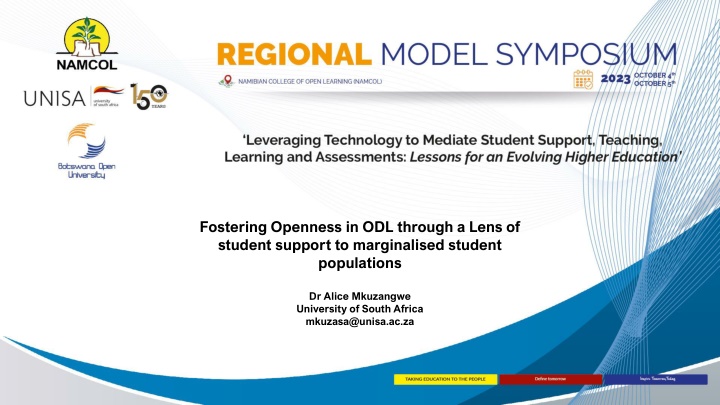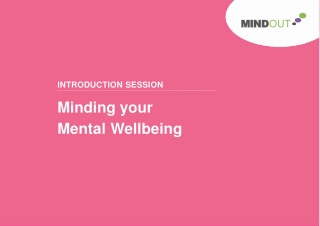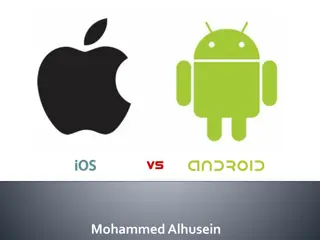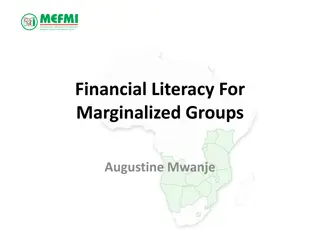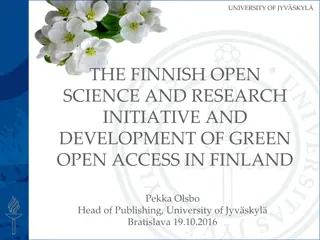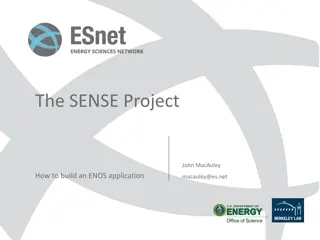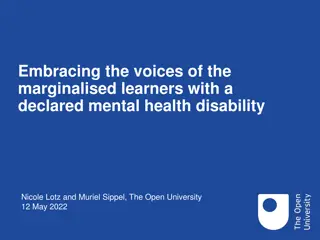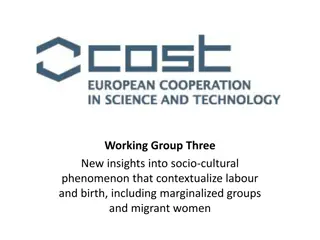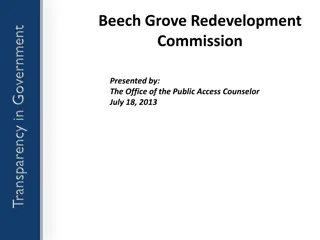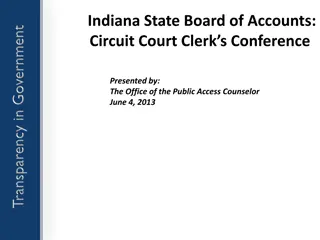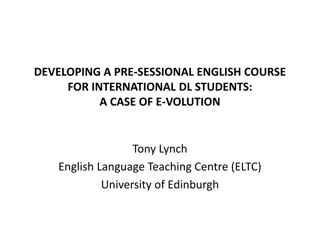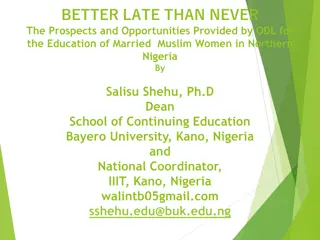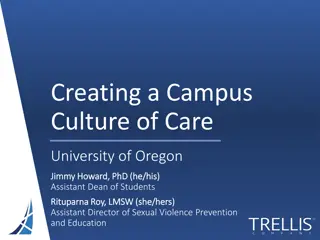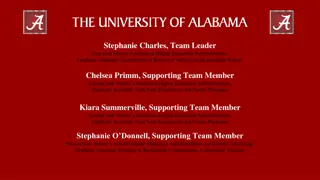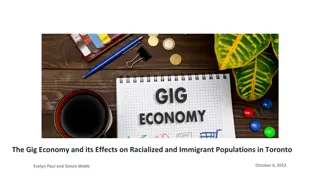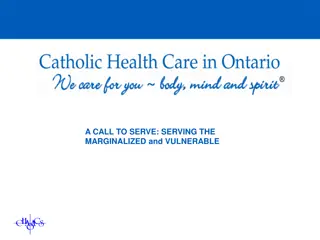Fostering Openness in ODL for Marginalized Students
Student access and success in universities, especially for marginalized populations, is a complex issue in South Africa. This study by Dr. Alice Mkuzangwe from the University of South Africa explores the dimensions of openness in Open and Distance Learning (ODL) and identifies factors affecting marginalized student populations' learning journey. The research aims to analyze access and success patterns, explore institutional, learner, and teacher-related factors contributing to openness, and evaluate the implementation of openness principles. It addresses challenges faced by students from marginalized communities in higher education systems.
Download Presentation

Please find below an Image/Link to download the presentation.
The content on the website is provided AS IS for your information and personal use only. It may not be sold, licensed, or shared on other websites without obtaining consent from the author.If you encounter any issues during the download, it is possible that the publisher has removed the file from their server.
You are allowed to download the files provided on this website for personal or commercial use, subject to the condition that they are used lawfully. All files are the property of their respective owners.
The content on the website is provided AS IS for your information and personal use only. It may not be sold, licensed, or shared on other websites without obtaining consent from the author.
E N D
Presentation Transcript
Fostering Openness in ODL through a Lens of student support to marginalised student populations Dr Alice Mkuzangwe University of South Africa mkuzasa@unisa.ac.za
OUTLINE INTRODUCTION PURPOSE AND OBJECTIVES LITERATURE REVIEW THEORETICAL FRAMING METHODOLOGY RESULTS CONCLUSION
INTRODUCTION Student access and success in universities is complex and multi-dimensional, South Africa s low student success rates are rooted in its basic education system. No single solution to the challenges of poor university student success rates exists, but that solutions must be understood as multi-dimensional [(Badat, 2010) and (Lewin & Moyo, 2014)]. In ODL increasing participation rates without the provision of support mechanisms to students in particular marginalised student populations has not yet addressed the relevant challenges experienced by this student group. If distance learning is considered as a model of provision in advancing openness, then the method for delivery and its learning materials must be reconfigured, where course materials are made available online to students attending lectures, either on or off campus. This should be followed by the employment of ICTs, technology provision should become the primary vehicle through which the curriculum is communicated and reflect in the practice of open and distance education. From this orientation a meaningful and holistic understanding of the institutional landscape and the student profiles will permeate through all institutional planning systems.
INTRODUCTION Dimensions of openness are considered with related factors impacting open distance education. The study offered a critical exploration of the concept of openness in higher education in the context of ODL, while focusing on the study pathways of previously disadvantaged or marginalised university students.
PURPOSE AND OBJECTIVES The purpose of the study was to identify and describe the range of institutional, learner and teacher-related factors that contribute to openness considerations that would support students in their learning journey. The study objectives involved : Conducting a situational analysis of access and success patterns Identifying and describe the range of institutional, learner and teacher-related factors that contribute to openness during the student study pathways Evaluate current performance in planning and implementation of the principles of openness across the chosen study site.
LITERATURE The South African higher education system is characterised by high enrolment numbers of students from marginalised communities with growing concerns with respect to the efficacy of the higher education system. Ramrathan, & Pillay (2015) posit that the system experiences a combination of high attrition or dropout rates, low throughput, low success rates, and increased time-to-completion in particular three year and four-year degree programmes. The DHET (2015) acknowledges the existence of these challenges and highlights the various interventions by the government have largely focused on opening and widening ac-cess to institutions offering contact and distance education, especially for students previously excluded. However, there is rarely evidence to suggest that improved access has resulted in comparable success rates, in particular for open and distance learning (ODL). Disparities in income levels and inequalities are significant in higher education and manifest in academic performance and success of students.
LITERATURE The disproportionate imbalance requires wide-ranging interventions on the interface of institution and state to drive improved efficacy of the system and outcomes. Nicholas, Cullen, and Koski (2021) argue that institutions structural alignment to its mission is important and to assist in gathering research, the Institutional Research (IR) departments whose focus predominantly is on institutional reporting and statistics as their primary scope should be expanded to include specialties in accreditation, assessment, analytics and other data services The challenges associated with ODL are varied, and central to these challenges is that the concept of openness is not well understood, that is, its true impact and application in practice are not fully understood. This picture of uncertainty about its contribution is a long-standing challenge. The principles of social justice must be reconciled with the environmental conditions that give expression on the amenability of the environment to acknowledge the disparities within its social spaces and intentional adoption of strategies to socialise the spaces to more equitable access and success.
LITERATURE Universities, by their very nature, are designed as social structures and institutional contexts or spaces with specified rules and regulations. Sapon-Shevin (2003) identifies inclusion as a principle that concerns social justice, and that by embracing inclusion as a model of social justice, institutions can create a world fit for the entire student body. Ding et al. (2021) highlights that the dramatic expansion in enrolment in an effort of inclusiveness without the sufficient complementary input in teaching resources and finance negatively affects the quality of education provision from various input factors. Faculty-student ratio, a key indicator of higher education quality indicating class size and faculty availability (Black & Smith, 2006),
THEORETICAL FRAMING A framework is defined as a collection of ideas that are used when someone is interested to form decisions or judgements (Bedworth, 2010). It assists the researcher to organise the specific study and delivers a perspective in the topic under study and collects and analyses data (Van den Brink & Stobbe, 2009).
THEORETICAL FRAMING Opening Up Education: A Support Framework for Higher Education Institutions (Adapted from Dos Santos, Punie, Casta o-Mu oz, 2016) Quality Technology Access Pedagogy Content Open Education Research Collaboration Recognition Leadership Strategy
THEORETICAL FRAMING The OpenEdu framework for opening up education was designed to contribute to the objective that Europe ought to provide the right policy framework and a stimulus to introduce innovation in learning and teaching practices in schools, universities, vocational education, and training. The framework comprises of 10 dimensions categorised into two groups: o Core dimensions of open education o Transversal dimensions of open education. The core dimensions of open education centre around the core practices of openness and present the 'what' of openness i.e. o Access, Content, Pedagogy, o Recognition, Collaboration, and Research. The transversal dimensions of open education provide the planning pillars for the realisation of the core dimensions, these are the 'how' of opening up educational practices. They continuously interface with the core dimensions and these dimensions are o Leadership, Strategy, o Quality, and Technology.
METHODOLODY The study adopted an exploratory, sequential mixed method design PHASE ONE o The situational analysis involved reviewing a wide-ranging information types that included the review of both quantitative and qualitative data, specifically secondary data sources from institutional records, DHET published statistics, and CHE statistics for the period 2012-2019 PHASE TWO o Individual interviews (N=19), n=9 (47%) fell within the category of academic staff management followed by n=6 (32%), Management and only n=4 (21%) represented the Administrative Middle Management category which also include staff in the professional designations such as quality assurance practitioners and educational technologists
METHODOLODY PHASE THREE o Statistical data to reflect numerical comparisons to draw correlational inferences. The correlational design was used to reflect of the findings of phase two. Data collection through the use of surveys, a self-complete questionnaire of the survey drew from the themes analysed from qualitative phase. The self-complete questionnaires were emailed to randomly identified, population samples of staff N = 1981 Qualitative Quantitative Situational Analysis
RESULTS SITUATIONAL ANALYSIS Cohort Enrolment and graduate patterns (institutional versus college level enrolments)
RESULTS SITUATIONAL ANALYSIS College Name 2012 2013 2014 2015 2016 2017 2018 2019 Average College of Accounting Sciences 8,0% 9,9% 12,2% 13,6% 12,9% 11,2% 13,5% 12,8% 11,8% College of Agriculture and Environmental Sciences 6,3% 9,8% 11,2% 12,0% 15,3% 13,6% 15,3% 15,3% 12,3% College of Economic and Management Sciences 6,0% 8,2% 9,4% 11,1% 15,1% 11,2% 12,0% 11,6% 10,6% College of Education Sciences 14,2% 16,8% 18,7% 17,4% 20,0% 19,7% 22,9% 20,9% 18,9% College of Graduate Studies 0,0% 6,3% 3,2% 5,6% 3,8% College of Human Sciences College of Law Sciences 7,2% 9,6% 12,4% 11,6% 15,6% 14,2% 14,9% 14,6% 12,5% 4,9% 5,2% 6,3% 6,0% 8,3% 7,9% 9,8% 8,6% 7,2% College of Sciences, Engineering and Technology Graduate School of Business Leadership 4,5% 5,8% 7,2% 7,5% 8,1% 7,6% 8,4% 8,5% 7,2% 24,8% 19,6% 22,8% 26,7% 29,9% 37,0% 42,2% 39,1% 30,3%
RESULTS SITUATIONAL ANALYSIS Year on year registrations to the university showed an upward trajectory which appears to be matched by similar proportional rates of graduation. The impact of increasing admissions is best understood by assessing the date of graduation i.e., the extent to which access performance is matched by success outcomes. Proportional graduation rates across race and ethnic groups appear to have remained static from 2012 to 2019. By proportion, white students headed the highest proportional rates of graduation ranging from 11.2% and 17.9%, which represent nearly one third more the rates of graduations that can be found in coloured and black-African students. This important observation highlights the fact that minimal corrective outcomes were evident over the eight-year index.
RESULTS SITUATIONAL ANALYSIS The review of the policy and strategic documents demonstrates a balanced approach by the institution to align its policies national policy frameworks and imperatives taking into consideration the positioning of open distance education in the South African higher education landscape. The challenge of enrolment numbers and ability of the institution to provide support to students is observed in the Senate report from Council on SRC Submissions to Council (2017) and the Task Team Report on the Academic Calendar and Student Registrations (2018). The policies that were reviewed are not clear on the institution s e-learning trajectory on whether it advances a blended learning strategy or there is a sustained commitment to e-learning pedagogy adoption or whether the institution adopts both, placing priority to blended learning is not clear. The ODeL policy advances both equitability but other policies such as the Tuition Policy (2013) and the Academic Teaching and Learning Strategy (2015) align more towards the blended learning strategies.
RESULTS QUALITATIVE The themes that emerged during the interviews demonstrate student support and the relational nexus with access is crucial in ensuring success. Understanding of openness o The respondents gave different views on the concept of openness. The varied responses overall demonstrated an incoherent view on the understanding of open education and its associated systems for provision. Student readiness for ODL o Nine respondents (N=9) identified the readiness to study in open distance and e-learning systems as a driver for success in openness. These participants articulated this driver from a collaborative learning system in that students should be co-creators of knowledge and that learning systems should promote flexible, open, collaborative learning beyond time, personality, and place constraints. Technology support o All nineteen respondents (N=19) interviewed identified the centrality of optimal technology platforms to drive open and e-learning. All participants agreed that the institution was challenged with technology provision.
RESULTS QUALITATIVE Lecturer workload and support o From the qualitative phase, respondents expressed views that the workload of lecturers compromises the quality of work and outputs. The workload of both students and the lecturers resulted in an inadequate student-lecturer relationship. University regional model o The respondents highlighted that the institution needed to reimagine its role for regional education provision in support and student learning needs. All participants agreed that the current regional model was incoherent, working to the disadvantage of Unisa students, and these were the very marginalised students. o Student shared the hindrances in accessing lecturers and further highlighted that some had to relocate for example, from one provincial region to the main campus in Gauteng in order to get support in Pretoria as the regional office in their hometown in a rural village was insufficiently resourced, paying additional money for rentals. o Decentralisation as a contributory factor in regional models found resonance with both individual interviews and student views,
RESULTS QUANTITATIVE Phase three applied statistical data to reflect numerical comparisons to draw cor-relational inferences to verify or refute the hypothesis of the study. The correlational design was used to reflect the findings of phase two and this design utilised a simple approach to identify patterns and correlations within the numbers from the survey instrument. The self-complete questionnaire was emailed to randomly identified staff population sample of 1981 and 35 589 students who satisfied the inclusion and exclusion criteria, deemed to be illegible for inclusion in the study by virtuated of being actively registered and currently in their final year of study at NQF levels 6,7 and 8. The themes that were considered in this phase were Institutional culture, policy and governance, access and admissions, technology and support and lastly pedagogy, and student engagement.
RESULTS QUANTITATIVE 5 points on the scale represented. The interval limits as set forth in the table were used to interpret the level of agreement or disagreement for each aspect once an aggregated view was presented.
RESULTS QUANTITATIVE Pedagogy, quality and student engagement o The study s respondents had an average rating of 4.33 and 88% (N=153) of them gave a rating of either 4 or 5 which suggests that on average, the staff Strongly Agree that openness dealt with pedagogy, social issues, cultural issues, political and technological issues, which cut across governance, university operations, systems and practices. Such a comprehensive picture ought to be realised first to effectively operationalize open education. Technological support o Technology, internet, and connectivity were observed as being the most prevalent challenges at UNISA. Technology planning and implementation is fundamental to advance open education for optimal teaching and learning. o The selected respondents had an average rating of 4.59 and 90% (N=157) of them gave a rating of either 4 or 5 which suggests that on average, the staff Strongly Agree that technology planning and implementation was fundamental to advance open education for optimal teaching and learning. o The respondents had an average rating of 3.98 and 71% (N=123) of them gave a rating of either 4 or 5 which suggests that on average, the UNISA staff Somewhat Agree that e-learning continued to lag in advancing open education practices.
RESULTS QUANTITATIVE o The respondents had an average rating of 3.95 and 69% (N=120) of them gave a rating of either 4 or 5 which suggests that on average, the staff Somewhat Agree that the impact of COVID-19 disrupted student learning and support. o The students had an average rating of 3.89 and 64% (N=346) of them gave a rating of either 4 or 5 which suggests that on average, they Somewhat Agree that there was a technology gap amongst students with respect to access. o Not all students were getting the same access and connectivity; technological advancements seemed to be concentrated in the urban centres, to the detriment of the marginalised students in the rural peripheries.
RESULTS QUANTITATIVE Staff workloads and the student-teacher relationship o The study s respondents had an average rating of 4.20 and 77% (N=134) of them gave a rating of either 4 or 5 which suggests that on average, the staff Strongly Agree that the workload of lecturers compromised the quality of work and out-puts. o The students had an average rating of 4.22 and 78% (N=418) of them gave a rat-ng of either 4 or 5 which suggests that on average, the participants Strongly Agree that UNISA needed to instil a better culture of student support. A further concurrence was observed in effective engagement with students. The students Strongly Agree that the institution needed to listen to students, and institutional decisions must be taken in accordance with what students identified as suitable for supporting the academic programmes.
CONCLUSION The presentation of the results was multi-fold, the quantitative results provide a confirmatory lens to the qualitative phase of the individual interviews. From the individual staff interviews, strong views were expressed on inadequate management of staff workloads, inappropriate provision of the technology platforms and its planned implementations. Alignment of policy principles and how they were operational-ized in practice, was expressed during the staff interviews. These themes were expected to emerge during the staff surveys as topical issues found in the institutional and student-teacher relational factors. The inadequacy of the institution s regional model was also expected to feature as a confirmatory theme during the staff survey. The results of the staff survey strongly demonstrate a concurrence that open- ness discourse at Unisa was incoherently understood.
REFERENCES Badat, S., 2005. South Africa: Distance higher education policies for access, social equity, quality, and social and economic responsiveness in a context of the diversity of provision. Distance education, 26(2), pp.183-204. Badat, S. The challenges of transformation in higher education and training institutions in South Africa. Development Bank of Southern Africa, 8(1), 1-37 (2010). Badat, S., 2010. The challenges of transformation in higher education and training institutions in South Africa. Development Bank of Southern Africa, 8, pp.1-37. Baloyi, G.P., 2012. Learner support in open and distance learning context: A case study of ABET programmes at the University of South Africa (Doctoral dissertation). Black, D.A. and Smith, J.A., 2006. Estimating the returns to college quality with multiple proxies for quality. Journal of labor Economics, 24(3), pp.701-728.
REFERENCES Bradbury, B., 2019. A mixed methods study of distance learning graduate stu-dents motivation and program satisfaction at an American State University. In: VII International Scientific and Technical Internet Conference Information Technologies in Educational Experience and Production , November 16-17, 2019. Creswell, J.W., Klassen, A.C., Plano Clark, V.L. and Smith, K.C., 2011. Best practices for mixed methods research in the health sciences. Bethesda (Maryland): National Institutes of Health, 2013, pp.541-545. Creswell, J.W., 2014. A concise introduction to mixed methods research. California. SAGE publications. Ding, Y., Wu, Y., Yang, J. and Ye, X., 2021. The elite exclusion: stratified access and production during the Chinese higher education expansion. Higher Education, pp.1-25. Ives, C. and Pringle, M.M., 2013. Moving to open educational resources at Athabasca University: A case study. International Review of Research in Open and Distributed Learning, 14(2), pp.1-13.
REFERENCES Koen, C., Cele, M. and Libhaber, A., 2006. Student activism and student exclusions in South Africa. International Journal of Educational Development, 26(4), pp.404-414. Lewin, T., & Mawoyo, M., 2014. Student access and success: Issues and interventions in South African universities. Report published by Inyathelo: The South African Institute for Advancement, with the support of The Kresge Foundation. Minnaar, A., 2013. Challenges for successful planning of open and distance learn-ing (ODL): A template analysis. The International Review of Research in Open and Distributed Learning, 14(3), pp. 81-108. Ngubane-Mokiwa, S., & Letseka, M., 2015. Shift from open distance learning to open distance e- learning. Open distance learning (ODL) in South Africa, 129.
